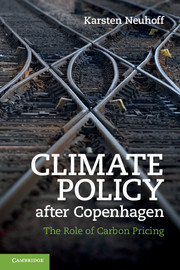Book contents
- Frontmatter
- Contents
- List of figures
- List of tables
- List of boxes
- Acknowledgements
- List of abbreviations
- 1 Introduction
- 2 The role of a climate policy mix
- 3 Implementing a carbon price: the example of cap and trade
- 4 Shifting investment to low-carbon choices
- 5 Co-operation among developed countries: a role for carbon markets?
- 6 A world of different carbon prices
- 7 International support for low-carbon growth in developing countries
- 8 Conclusion
- References
- Index
7 - International support for low-carbon growth in developing countries
Published online by Cambridge University Press: 05 June 2012
- Frontmatter
- Contents
- List of figures
- List of tables
- List of boxes
- Acknowledgements
- List of abbreviations
- 1 Introduction
- 2 The role of a climate policy mix
- 3 Implementing a carbon price: the example of cap and trade
- 4 Shifting investment to low-carbon choices
- 5 Co-operation among developed countries: a role for carbon markets?
- 6 A world of different carbon prices
- 7 International support for low-carbon growth in developing countries
- 8 Conclusion
- References
- Index
Summary
During the Kyoto negotiations in 1997, only developed countries agreed to emissions-reduction targets. This reflected the principle of common but differentiated responsibility (Article 3(1), UNFCCC 1997). At the time, developed countries accounted for the majority of greenhouse gas emissions. Since then, many developing countries have exhibited impressive economic performance and a few countries have become richer in terms of GDP per capita than developed countries. As the economic development has largely followed the model set by Europe and the USA, early investment has focused on infrastructure built on cement, steel and manufacturing industries, and powered largely by fossil fuels, resulting in significant emissions.
Figure 7.1 illustrates how this has shifted the balance of emissions over the period 1990–2007. Counties such as the USA and Canada continue to exhibit extraordinarily high per capita CO2 emissions (y-axis) and emissions grew in line with population by 20 per cent. Emissions by economies in transition fell, with the structural changes after the fall of the Berlin Wall and efficiency improvements in industry, and are now at the level of per capita emissions of Western European countries in 1990. Western Europe achieved a 7 per cent per capita emissions reduction since 1990. With strong economic growth, per capita CO2 emissions in both China and India increased by 128 per cent. In addition, the populations of Asian and African countries have been growing. In aggregate, developing countries constituted 51 per cent of global CO2 emissions in 2007 (32 per cent in 1990).
- Type
- Chapter
- Information
- Climate Policy after CopenhagenThe Role of Carbon Pricing, pp. 203 - 236Publisher: Cambridge University PressPrint publication year: 2011



